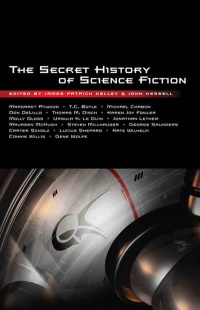What if this entire planet were made of the same substance as Isol’s engine? What if the whole system was too? Suppose it wasn’t ordinary matter, but only looked like it at certain levels? Then a planet might talk, might think, might do as it wanted.
But what was the “it”?
Title: Natural History
Author: Justina Robson
Year: 2003
Rating: 3/5 stars
 This book represents my first encounter with British sf writer Justina Robson, and my initial impression is that of a solid, if not necessarily spectacular, writer and novel. The action takes place several centuries in the future. Mankind has undergone a self-directed evolution, with the ability to design many different body types for almost any conceivable purpose. Genetic engineering and other advanced technologies have resulted in a new branch of humanity, the Forged. A Forged individual might have a body adapted to survive the pressure of the deep ocean, or with the ability to fly, or to travel through space without an external vehicle, or any of a multitude of possibilities. There are even Forged capable of terraforming other planets, turning the entire Solar System into humanity’s home. Of course the Forged represent only a portion of the species. The rest choose to change in less drastic ways (various levels of cybernetic enhancement), or not at all. These latter are known as the Unevolved or, as many of the Forged call them, Old Monkey.
This book represents my first encounter with British sf writer Justina Robson, and my initial impression is that of a solid, if not necessarily spectacular, writer and novel. The action takes place several centuries in the future. Mankind has undergone a self-directed evolution, with the ability to design many different body types for almost any conceivable purpose. Genetic engineering and other advanced technologies have resulted in a new branch of humanity, the Forged. A Forged individual might have a body adapted to survive the pressure of the deep ocean, or with the ability to fly, or to travel through space without an external vehicle, or any of a multitude of possibilities. There are even Forged capable of terraforming other planets, turning the entire Solar System into humanity’s home. Of course the Forged represent only a portion of the species. The rest choose to change in less drastic ways (various levels of cybernetic enhancement), or not at all. These latter are known as the Unevolved or, as many of the Forged call them, Old Monkey.
That somewhat demeaning moniker should give you a clue about relations between the various types of humans; those relations are strained. The Forged have long been used almost as a slave labor force, and many resent their bondage to “Form and Function,” the idea that because their bodies were designed for a certain task then their lives must be constrained by that task. The entire novel takes place against the backdrop of an almost inevitable civil war, and raises pertinent questions about the political and social consequences when humanity begins to drastically alter itself in such a fashion, creating such differentiated versions of the species.
So that’s the background. The actual plot gets underway when Voyager Lonestar Isol, a Forged deep space explorer, comes across the first evidence of alien life. “Life” might not be accurate because, well, it’s no longer alive. But Isol also encounters a piece of alien technology that begins to change her, ultimately in more drastic ways than her human creators ever did. Nearby is a planet that appears to be the home of the apparently vanished architects of that technology, and Isol is strangely drawn to it; she dreams of using it as a new home for the Forged, for all those Forged who wish to break free from Old Monkey and start directing their own destiny. But that planet is not what it seems, and the technology Isol found is far more powerful and mind-boggling — and dangerous — than anyone could have imagined.
I really like some things about this novel. Robson does a fair job of examining issues of transformation and identity; how much are people willing to change their bodies, and what still counts as “human”? There are some very interesting scientific concepts woven into the story as well. Where I felt it was weak was in the overall level of immersion and believability. There was not enough attention given to world-building detail; this entire future society seemed like a mere sketch and thus was a little hard to fully buy into. The same is true of some of the characters; it was difficult to get inside their heads and understand their real motivations on any deep level. Or sometimes I knew a character’s motivation, but not why that motivation existed or where it came from. This is one case where I think a novel would have benefited from being a little bit longer and fleshed out a bit more (it’s 325 pages, actually not that long for contemporary sf). As it stands, though, I think the pros outweigh the cons enough to consider this a sufficiently rewarding reading experience.














